Solitary waves induce waveguide that can split light beams (Vol. 43 No. 3)
 Formation of the multiple dark photovoltaic solitons from even initial conditions in steady state regime.
Formation of the multiple dark photovoltaic solitons from even initial conditions in steady state regime.
Simulations are performed to help understand the occurrence of multiple solitary optical waves that are used to reconfigure optical beams. Researchers have designed the first theoretical model that describes the occurrence of multiple solitary optical waves, referred to as dark photovoltaic spatial solitons. Because the shape of dark solitons remains unaffected by the crystal in which they travel, they induce waveguides, which can be used, for example, to reconfigure optical beams by splitting them.
Dark solitons are generated in so-called photorefractive crystals - crystals that respond to an incoming light beam by decreasing their refractive index as optical intensity increases, causing the incoming beam to defocus. This effect is called nonlinear self-defocusing. Dark solitons occur when the diffraction of an incoming beam by the notch, located at the crystal's entrance, is compensated by the crystal's self-defocusing effect. As a result, dark solitons can induce waveguides for light beams, allowing them to travel unchanged through photorefractive crystals.
The authors develop the first numerical simulation to model the formation and evolution of one-dimensional multiple dark solitons inside a photorefractive crystal, relying on an approximation technique called the beam propagation method. By expanding the width of the dark notch located at the entrance of the crystal, which, unlike in previous studies, was not given any special function, they showed it was possible to create multiple dark solitons.
These solitons appeared in either odd or even numbers, depending on the initial beam phase or amplitude. The authors also confirmed previous findings that showed that when multiple solitons are generated, the separation between them becomes smaller. Further, the solitons become progressively wider and less visible, the farther away they are from the main dark notch entry location.
Steady-state multiple dark photovoltaic spatial solitons
Y. Zhang, K. Lu, J. Guo, K. Li and B. Liu, Eur. Phys. J. D, 66, 65 (2012)
[Abstract]
Space science (Vol. 51, No. 4)
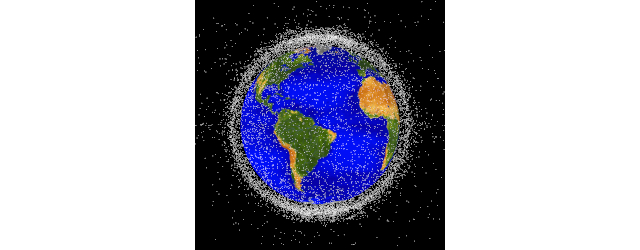
Space exploration is moving into a new era, with the focus of science and research move from one-off achievements and firsts, to the establishment of frameworks that will encourage sustainability.
At the same time, the more we learn about space, the more we realise that plans must be put in place to mitigate threats from beyond our own atmosphere. In an EPJ-ST Special Topics issue on 'Celestial Mechanics in the XXIst Century' in particular studies related to the risk of collisions of space vehicles with space debris and strategies to avoid a collision of an asteroid with the Earth are presented.
Reducing the risk of space debris collision
A plausible method of clearing space debris could be achieving through the use of a tug vehicle that requires a successful connection procedure.
de Jesus, A.D.C., Santos, G.L.F., Reducing the risk of space debris collisions using conditions or performance simultaneous operation in minimum time. Eur. Phys. J. Spec. Top. 229, 1419–1427 (2020)
[Abstract]
Protecting Earth from asteroid impact with a tethered diversion
The use of a tether assisted system could prevent an asteroid impacting Earth without the risk of fragmentation.
Venditti, F. C. F., Marchi. L. O., Misra. A. K, Sanchez. D. M., Prado. A. F. B. A. , Dynamics of tethered asteroid systems to support planetary defence, Eur. Phys. J. Spec. Top. 229, 1463–1477 (2020)
[Abstract]
Spacecrafts get a boost in ‘Aerogravity Assisted’ interactions
New research examines the effect of rotation and other variables in the applications of ‘Aerogravity Assisted’ manoeuvres to obtain an energy boost for space crafts.
Piñeros. J. O. M., Gomes. V. M., dos Santos. W. A., Golebiewska J. , Effects of the rotation of a spacecraft in an atmospheric close approach with the Earth, Eur. Phys. J. Spec. Top. 229, 1517–1526 (2020)
[Abstract]
Spatial scales in electricity system modelling (Vol. 49, No. 1)
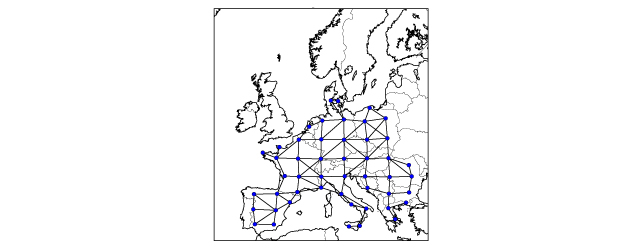
Models of large-scale electricity systems often only incorporate a certain level of spatial detail regarding the distribution of generation and consumption. This coarse-graining due to constrained availability of data or computational limitations also applies to the representation of the power grid. In particular, the network topology as well as the load and generation patterns below a given spatial scale have to be aggregated into representative system nodes. But how does this coarse-graining affect what simulations tell us about the system? This important question has been addressed using a simplified, but spatially-detailed model of the European electricity system with a high share of renewable generation. Applying a clustering algorithm, the transmission needs of the system are derived on various spatial scales. Surprisingly, it turns out that the transmission infrastructure costs only vary weakly under the coarse-graining procedure. This can be understood using an analytical approach, which yields approximate spatial scaling laws for measures of transmission infrastructure in electricity system models.
M. Schäfer, S. B. Siggaard, K. Zhu, C. R. Poulsen and M. Greiner, Scaling of transmission capacities in coarse-grained renewable electricity networks, EPL 119, 38004 (2017)
[Abstract]
Speed of sound in a complex plasma under microgravity (Vol. 43 No. 2)
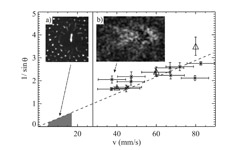 Mach cone relation linking the Mach cone angle θ with the probe particle speed v in experiments (crosses) and simulation (triangles). (a) Zoom showing the subsonic probe particle. (b) Smoothed difference between two successive frames, highlighting the Mach cone.
Mach cone relation linking the Mach cone angle θ with the probe particle speed v in experiments (crosses) and simulation (triangles). (a) Zoom showing the subsonic probe particle. (b) Smoothed difference between two successive frames, highlighting the Mach cone.
Complex plasma experiments under microgravity conditions in the International Space Station ISS, complementing research on Earth, are very important for the progress in this field. Complex plasmas consist of micrometre-sized highly charged particles ("microparticles") embedded in an ionized gas ("plasma"). The microparticle ensemble resembles a classical system of interacting atoms. This system can form all of the classic phases, i.e., crystalline, liquid and gaseous. It can also support the propagation of sound waves, solitons and shock waves.
In experiments carried out on Earth, gravity pulls the microparticles downwards resulting in two-dimensional structures. Under microgravity conditions it is possible to investigate big, three-dimensional systems. The PK-3 Plus laboratory provides ideal conditions for such experiments. It is installed in the Russian segment of the ISS and has been used repeatedly over the last 6 years.
We performed experiments to measure the speed of sound during two missions with cosmonauts Volkov and Skvortsov. In Figs. (a) and (b) we show how a bigger "probe" particle penetrated a cloud of smaller microparticles. At a speed several times faster than the speed of sound it excited a Mach cone. A double cone structure is discernible in this "atomistic" system. While moving through the cloud, the probe particle is decelerated to subsonic speeds. By measuring the Mach cone angle at several probe particle velocities, we determined the Mach relation. This allows us to directly measure the speed of sound and to infer the microparticle charge. In addition, the experimental results agree well with a 3D molecular-dynamics simulation, demonstrating in particular a double Mach cone structure.
Direct measurement of the speed of sound in a complex plasma under microgravity conditions
M. Schwabe, K. Jiang, S. Zhdanov, T. Hagl, P. Huber, A. V. Ivlev, A. M. Lipaev, V. I. Molotkov, V. N. Naumkin, K. R. Sütterlin, H. M. Thomas, V. E. Fortov, G. E. Morfill, A. Skvortsov and S. Volkov, EPL, 96, 55001 (2011)
[Abstract]
Speed-dependent attraction governs what goes on at the heart of midge swarms (Vol. 48, No. 3)
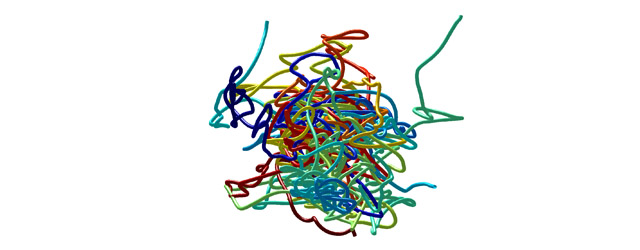
New study reveals swarm cohesion stems from an adaptive behaviour, where the faster individual midges fly, the stronger the gravitational-like force they experience.
Ever wondered what makes the collective behaviour in insect swarms possible? The authors modelled the effect of the attraction force, which resembles Newton’s gravity force, acting towards the centre of a midge swarm to give cohesion to their group movement. In a recently published work, their model reveals that the gravity-like attraction towards the heart of the swarm increases with an individual’s flight speed. The authors confirmed the existence of such an attractive force with experimental data. They chose to focus on insect swarms, rather than bird flocks or fish shoals, because interactions between neighbouring individuals appear not to play a key role. This makes insect swarms easier to model. Instead of building a model describing the microscale movement of individuals and confronting it with experimental data, the authors built a model of swarm behaviour that is consistent with experimental observations, in terms of swarm density, of individual midges’ speed and acceleration.
A. M. Reynolds, M. Sinhuber and N. T. Ouellette, Are midge swarms bound together by an effective velocity-dependent gravity?, Eur. Phys. J. E 40, 46 (2017)
[Abstract]
Spin flip in ionization of highly charged ions (Vol. 45 No.3)
 The qualitatively different behavior of spin in strong laser fields, within SFA (left) and the proposed theory (right). Spin effects in the tunneling regime of ionization are built up in three steps: spin precession in the bound state, during tunneling, and during the motion in continuum. Only the last two steps are included in SFA. The red, blue and green arrows indicate the initial spin, the spin after the tunneling, and the final spin, respectively. The spin quantization axis is along the laser propagation direction.
The qualitatively different behavior of spin in strong laser fields, within SFA (left) and the proposed theory (right). Spin effects in the tunneling regime of ionization are built up in three steps: spin precession in the bound state, during tunneling, and during the motion in continuum. Only the last two steps are included in SFA. The red, blue and green arrows indicate the initial spin, the spin after the tunneling, and the final spin, respectively. The spin quantization axis is along the laser propagation direction.
How does the electron’s spin evolve during atomic ionization in a strong laser field? A new theoretical result obtained by the authors shed light on this relativistic quantum phenomenon. It was shown that even if an electron is very tightly bound by the strong Coulomb field in a highly charged ion, the spin dynamics may still be crucially affected by a strong laser field of relatively moderate intensity, see figure. This effect is beyond the commonly accepted Strong-Field-Approximation (SFA) and can be confirmed in a challenging experiment employing collisions of highly charged ions with ultra-strong laser beams.
M. Klaiber, E. Yakaboylu, C. Müller, H. Bauke, G. G. Paulus and K. Z. Hatsagortsyan, “Spin dynamics in relativistic ionization with highly charged ions in super-strong laser fields”, J. Phys. B: At. Mol. Opt. Phys., 47, 065603 (2014)
[Abstract]
Spin freezing and the Sachdev-Ye model (Vol. 50, No. 2)

The infinite-range, random-exchange Heisenberg spin model introduced in 1993 by Sachdev and Ye describes a non-Fermi liquid metal without quasi-particles, which resembles the bad-metal state of unconventional superconductors. Because of the somewhat artificial nature of the model, it is however not obvious how to connect this result to phenomena observed in strongly correlated materials. The latter are typically described by the Hubbard model and its multi-orbital extensions. Interestingly, the same non-Fermi liquid exponents as in the Sachdev-Ye model are generically observed in the correlated metallic phase of multi-orbital Hubbard models with Hund coupling. Our analysis suggests that the Sachdev-Ye model can be regarded as an effective description of a spin-freezing crossover regime with fluctuating local moments and that the variance of the random coupling in the Sachdev-Ye model is related to the Hund coupling. This analogy provides new insights into the nature of non-Fermi liquid metals, and into the close connection between spin freezing and unconventional superconductivity.
Ph. Werner, A.J. Kim and Sh. Hoshino, Spin freezing and the Sachdev-Ye model, EPL 124, 57002 (2018)
[Abstract]
Spin waves in nanowires with step-modulated thickness (Vol. 45 No.3)
 (a) Schematic drawing of the nanowire array and (b) comparison between the measured (points) and calculated (curves) collective SW frequency.
(a) Schematic drawing of the nanowire array and (b) comparison between the measured (points) and calculated (curves) collective SW frequency.
It is experimentally demonstrated that collective Bloch spin waves (SWs) propagate in a magnonic crystal consisting of a dense periodic array of nanowires with step-modulated thickness. The SW dispersion (frequency vs wave vector k) was measured using the Brillouin light scattering technique by sweeping the wave vector perpendicularly to the wire length. The investigated permalloy NWs have the total width of w=300 nm and periodicity a=415 nm. These nanowires consist of two sub-wires of widths w1=120 nm and w2=180 nm and thicknesses t1=25 nm and t2=50nm, respectively. Remarkably, the lowest frequency mode has an oscillating dispersion as a function of k while modes at higher frequencies have almost constant frequency values. These results have been successfully reproduced in a numerical simulation employing two-dimensional Green’s function description of the dynamic dipole field of the precessing magnetization. The theory also allowed visualizing the non-trivial distribution of dynamic magnetization across the wire cross-section and estimating the Brillouin light scattering cross-section. This work can stimulate the design, tailoring, and characterization of SWs band structure in three dimensional magnonic crystals.
G. Gubbiotti et al., “Collective spin waves on a nanowire array with step-modulated thickness”, J. Phys. D: Appl. Phys., 47, 105003 (2014)
[Abstract]
Spin-charge locking and tunnelling into a helicalmetal (Vol. 42, No. 3)
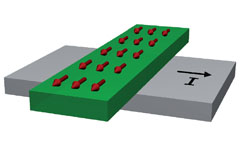 a ferromagnet (green) that is coupled to a topological insulator (grey) such
that electrons can tunnel between the two materials. it is found that a current
flowin the surface states of the topological insulator strongly modifies the
tunnelling current.
a ferromagnet (green) that is coupled to a topological insulator (grey) such
that electrons can tunnel between the two materials. it is found that a current
flowin the surface states of the topological insulator strongly modifies the
tunnelling current.
Spintronics aims at exploiting the electron spin for new device functionalities. In recent years a new spintronic paradigm, based on the spin-orbit interaction, has been proposed aiming to gain spin control by electric fields. In this respect, topological insulators (TI) appear as a very promising opportunity. At the surface of aTI gapless excitations occur with extraordinarily strong spinorbit coupling: a given surface momentum is associated with a single spin direction, such that the states on the Fermi surface have a well-defined helicity.
In this paper we present a theoretical study of the dynamics of the electrons moving on the surface of a three-dimensional TI, i.e. in a two-dimensional helical metal (HM). When the HM is brought into contact with a ferromagnet, there arises an unconventional magnetoresistance. The origin of the effect is the spin-orbit coupling: since the electron momentum is connected to a single spin state, a current flow creates a nonequilibrium spin polarization. This current-induced spin polarization increases or decreases the spin dependent voltage difference between the helicalmetal and themajority or minority carriers in the FM and thus modifies the tunnelling current. By reversing the flow of the current in the helical metal the two spin species exchange their role. In the ideal case the tunnelling current between the FM and the HM can be switched on and off depending on the relative orientation of the magnetization of the FM with respect to the direction of the current flow in the HM.
Spin-Charge Locking and Tunnelling into a HelicalMetal
P. Schwab, R. Raimondi and C. Gorini, EPL 93, 67004 (2011)
[Abstract]
Spin-charge-density wave in a rounded-square Fermi surface for ultra-cold atoms (Vol. 43 No. 3)
 Band structure: the Fermi energy (concentric squircles) is depicted by white contours (see also projection into the momentum plane).
Band structure: the Fermi energy (concentric squircles) is depicted by white contours (see also projection into the momentum plane).
Ultra-cold atoms in optical lattices can nearly ideally realize the simple Hamiltonians that model the behaviour of real condensed-matter systems, but with full control of parameters. Here, we show that Raman coupled ultra-cold fermions in a two-dimensional square optical lattice can have a different behaviour depending on their position in the lattice: at a certain site, the system gains energy if the fermion flips its spin, whereas in the sites around this one, the same process costs energy. This physical system is described by a tight-binding model with a Zeeman coupling that is different for neighbouring sites, thus dividing the lattice into AB sublattices. The single-particle spectrum has four bands; the third of which is shaped like a squarish Mexican hat (Figure). By filling up the energy levels up to the third band, the Fermi surface is squircle-shaped. This squarish-circle favours nesting and the system develops a coupled modulation in the density and spin, analogous to a spin-charge-density wave in solid- state systems.
Using field-theoretical methods, we develop a generalized formalism, which allows us to account for coupled charge and spin degrees of freedom simultaneously. We then determine the critical value of the parameters for the occurrence of the phase transition to this inhomogeneous density and spin state, which occurs at an incommensurate wave vector. Our results could be observed with state-of-the-art spectroscopic techniques. The investigation of spin-dependent optical lattices is an important direction of research in the field of spintronics with ultra-cold atoms, which will further strengthen the bonds between condensed matter and atomic physics.
Spin-charge-density wave in a rounded-square Fermi surface for ultra-cold atoms
D. Makogon, I. B. Spielman and C. Morais Smith, EPL, 97, 33002 (2012)
[Abstract]
Spinning quantum dots (Vol. 51, No. 2)

A theoretical analysis of electron spins in slowly moving quantum dots suggests these can be controlled by electric fields.
‘Quantum dots’ are particles of semiconducting materials that are so tiny – a few nanometres in diameter – that they no longer behave quite like ordinary, macroscopic matter. Thanks to their quantum-like optical and electronic properties, they are showing promise as components of quantum computing devices, but these properties are not yet fully understood. In this work the theory behind some of these novel properties is described in detail.
Prabhakar, S. and Melnik, R. , Berry phase and spin precession without magnetic fields in semiconductor quantum dots, European Physical Journal B 92, 263 (2019)
[Abstract]
Spotting the invisible cracks in wind turbines (Vol. 44 No. 4)
 Wind turbines can be weakened by unsuspected damages. (Credit: kovik)
Wind turbines can be weakened by unsuspected damages. (Credit: kovik)
A new approach is available for real-time monitoring of the structural health of wind turbine components during exposure to turbulences. The method is developed for analysing the elastic characteristics of mechanical structures subjected to disturbances, akin to the turbulences affecting wind turbines.
A significant percentage of the costs of wind energy is due to wind turbine failures, as components are weakened under turbulent air flow conditions and need to be replaced. The challenge for the team was to find a method for detecting fatigue in the wind turbines’ parts without having to remove each of the components and while the turbine is in operation. Until now, standard methods have relied on so-called spectral analysis, which looks at the different frequency response. But these measurements are distorted by the turbulent working conditions and often only detect really major damages.
The analytical method developed by the authors enables a distinction between dynamics attributed to mechanical properties, such as stiffness of the blade, and those attributed to interfering noise, such as turbulences. The authors demonstrated that they were able to precisely detect the changing mechanical properties of the beam material based on an analysis of the mechanical vibrations.
P. Rinn, H. Heiβelmann, M. Wächter and J. Peinke, ‘Stochastic method for in-situ damage analysis’, Eur. Phys. J. B, 86, 3 (2013)
[Abstract]
Spurious switching points in traded stock dynamics (Vol. 43 No. 5)
 Trends in stock prices dynamics are notoriously difficult to interpret.
Trends in stock prices dynamics are notoriously difficult to interpret.
A selection of biased statistical subsets could yield an inaccurate interpretation of market behaviour and financial returns.
In the present paper, the authors rebuff the existence of power laws governing the dynamics of traded stock volatility, volume and intertrade times at times of stock price extrema, by demonstrating that what appeared as “switching points” in financial markets trends was due to a bias in the interpretation of market data statistics.
A prior study based on conditional statistics suggested that the local maxima of volatility and volume, and local minima of inter-trade times are akin to switching points in financial returns, reminiscent of critical transition points in physics. These local extrema were thought to follow approximate power laws.
To disentangle the effect of the conditional statistics on the market data trends, the authors compare stock prices traded on the financial market with a known statistical model of price featuring simple random behaviour, called Geometrical Brownian Motion (GBM). They demonstrate that “switching points” occur in the GBM model, too.
The authors find that, in the case of volatility data, the misguided interpretation of switching points stems from a bias in the selection of price peaks that imposes a condition on the statistics of price change, which skews its distributions. Under this bias, switching points in volume appear naturally due to the volume-volatility correlation. For the intertrade times, they show that extrema and power laws result from the bias introduced in the format of transaction data.
V. Filimonov and D. Sornette, ‘Spurious trend switching phenomena in financial markets’, Eur. Phys. J. B 85 , 155 (2012)
[Abstract]
Stable p-type conductivity in Bi-doped ZnO (Vol. 42, No. 6)
Zinc Oxide (ZnO) has potential applications in varistors, light emitting diodes and photo detectors. The primary obstacle against its use in optoelectronic devices is the lack of stable p-type material. ZnO is naturally an n-type material, its majority carriers being electrons and it must be doped to become p-type. Most p-type dopants introduce either deep or shallow acceptors and the resulting material is p-type with either very low carrier concentration or unstable conductivity. Many previous efforts to synthesize p-type ZnO used N, As and P as dopants. In the present study bismuth has been chosen.
Thin films of Bi-doped ZnO were grown with a pulsed laser deposition system using a homogeneous target. Sample thickness was about 150 nm. XRD results showed the wurtzite structure of the films and XPS confirmed the presence of Bi. No evidence of secondary phases was found. From Hall measurements made over repeated cycles, in-situ annealed 3 and 5% Bi-doped samples are p-type. However as-grown 3% doped films showed unstable p-type conductivity, which suggests that some form of activation of Bi in ZnO occurs during the post-growth annealing leading to the p-type conduction. In the as grown 5% doped samples, the Bi concentration seems high enough to impose p-type conduction. Bi substitution in ZnO lattice is known to produce acceptors; this is the case here as shown by photoluminescence experiments. Carrier concentrations were 5.4 x 1018 and 4.8 x 1019 cm-3 in annealed 3% and 5% Bi-doped samples, respectively. Temperature-dependent photoluminescence leads to an acceptor energy level at about 0.13 eV above the valence band. The p-type conductivity of these Bi-doped ZnO thin films is stable under oxygen-rich ambient or upon annealing. Thus, this study suggests a possible pathway for developing ZnO based optoelectronic devices.
Study of stable p-type conductivity in bismuth-doped ZnO films grown by pulsed-laser deposition
J. W. Lee, N. G. Subramaniam, J. C. Lee, S. Kumar S and T. W. Kang, EPL, 95, 47002 (2011)
[Abstract]
Statistical physics approach to graphical games (Vol. 42, No. 3)
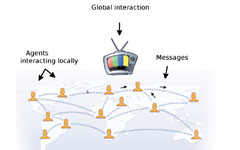 network of agents playing a graphical game. The payoff matrices depend both
on the local neighbourhoods and on some aggregate signal. The equilibriums
are reached by exchanging localmessages and their overall geometrical structure
can be analyzed by statistical physics techniques.
network of agents playing a graphical game. The payoff matrices depend both
on the local neighbourhoods and on some aggregate signal. The equilibriums
are reached by exchanging localmessages and their overall geometrical structure
can be analyzed by statistical physics techniques.
A graphical game is a mathematical framework to analyse strategic interactions among self-interested agents who play only with their neighbours in a graph. It usually makes predictions in terms of equilibrium concepts, chief among which is the Nash equilibrium: a configuration of strategies where nobody has a unilateral incentive to deviate. The problem of finding a Nash equilibrium is believed to be computationally intractable. In this work we show how to use methods from statistical physics of disordered systems to develop efficient and fully distributed (approximate) algorithms to tackle this problem. Furthermore, motivated by the recent interest in the study of the interplay between local and global interactions in multi-agent systems, we propose a new compact representation of games that extends over graphical games to deal conveniently with a global interaction and show how to extend the methods to this new case. We also derive the phase diagrams of different ensembles of random graphical games and study the structure of the corresponding space of solutions. Evidence of HARD/EASY phase transitions is found in some cases.
Statistical physics approach to graphical games: local and global interactions
A. Ramezanpour et al., Eur. Phys. J. B 80, 555 (2011)
[Abstract]
Subcategories
- Highlights
- Vol. 41 No. 6 - Highlights
- Vol. 42 No. 3 - Highlights
- Vol. 41 No. 5 - Highlights
- Vol. 42 No. 1 - Highlights
- Vol. 42 No. 2 - Highlights
- Vol. 42 No. 4 - Highlights
- Vol. 42 No. 5 - Highlights
- Vol. 43 No.2 - Highlights
- Vol. 42 No. 6 - Highlights
- Vol. 43 No.1 - Highlights
- Vol. 43 No.3 - Highlights
- Vol. 43 No.4 - Highlights
- Vol. 43 No.5 - Highlights
- Vol. 43 No.6 - Highlights
- Vol. 44 No.1 - Highlights
- Vol. 44 No.2 - Highlights
- Vol. 44 No.3 - Highlights
- Vol. 44 No.4 - Highlights
- Vol. 44 No.5 - Highlights
- Vol. 45 No.1 - Highlights
- Vol. 45 No.2 - Highlights
- Vol. 45 No.3 - Highlights
- Vol. 45 No.4 - Highlights
- Vol. 45 No.5-6 - Highlights
- Vol. 46 No.1 - Highlights
- Vol. 46 No.2 - Highlights
- Vol. 46 No.3 - Highlights
- Vol. 46 No.4 - Highlights
- Vol. 46 No.5-6 - Highlights
- Vol. 47 No.1 - Highlights
- Vol. 47 No.2 - Highlights
- Vol. 47 No.3 - Highlights
- Vol. 47 No.5-6 - Highlights
- Vol. 48 No. 1 - Highlights
- Vol. 48 No. 2 - Highlights
- Vol. 48 No. 3 - Highlights
- Vol. 48 No.4 - Highlights
- Vol. 48 No.5-6 - Highlights
- Vol. 49 No.1 - Highlights
- Vol. 49 No.2 - Highlights
- Vol. 49 No.3 - Highlights
- Vol. 49 No. 4 - Highlights
- Vol. 49 No. 5-6 - Highlights
- Vol. 50 No. 1 - Highlights
- Vol. 50 No. 2 - Highlights
- Vol. 50 No. 3 - Highlights
- Vol. 50 No. 4 - Highlights
- Vol. 50 No. 5-6 - Highlights
- Vol. 51 No. 1 - Highlights
- Vol. 51 No. 2 - Highlights
- Vol. 51 No. 3 - Highlights
- Vol. 51 No. 4 - Highlights
- Vol. 51 No. 5 - Highlights
- Vol. 52 No. 1 - Highlights







